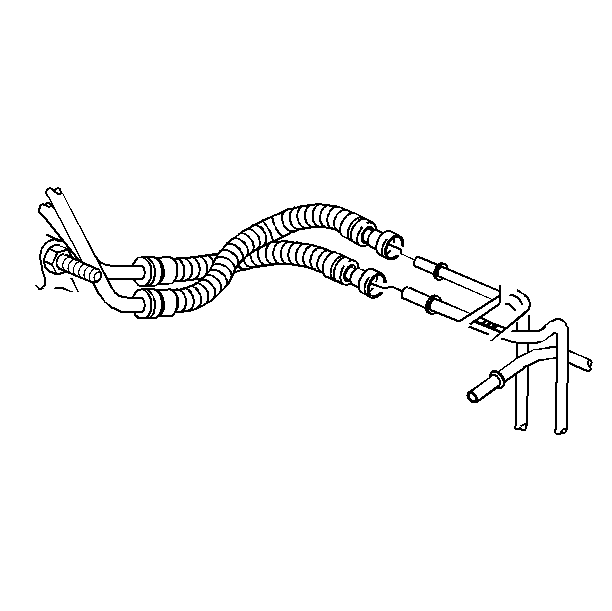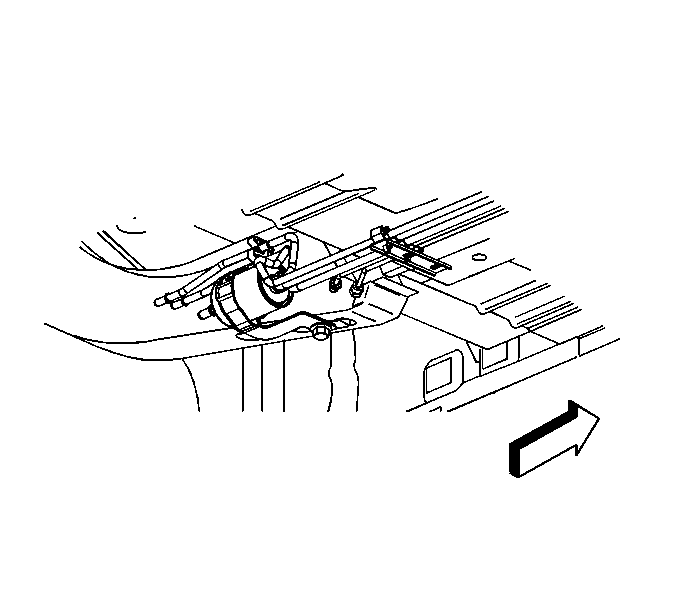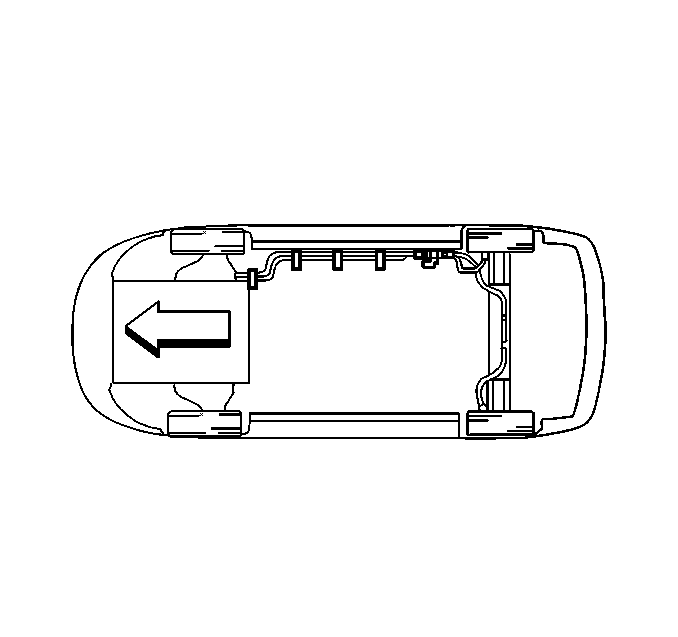Removal Procedure
Caution: In order to Reduce the Risk of Fire and Personal Injury:
• If nylon fuel pipes are nicked, scratched or damaged during installation,
Do Not attempt to repair the sections of the nylon fuel pipes. Replace them. • When installing new fuel pipes, Do Not hammer directly on the
fuel harness body clips as it may damage the nylon pipes resulting in a possible
fuel leak. • Always cover nylon vapor pipes with a wet towel before using a
torch near them. Also, never expose the vehicle to temperatures higher than
115°C (239°F) for more than one hour, or more than 90°C (194°F)
for any extended period. • Before connecting fuel pipe fittings, always apply a few drops
of clean engine oil to the male pipe ends. This will ensure proper reconnection
and prevent a possible fuel leak. (During normal operation, the O-rings located
in the female connector will swell and may prevent proper reconnection if
not lubricated.)
Notice: Cap the fittings and plug the holes when servicing the fuel system in order to prevent dirt and other contaminants from entering the open pipes and passages.
Important: Always maintain cleanliness when servicing fuel system components.
- Remove the air cleaner intake duct. Refer to Air Cleaner Inlet Duct Replacement .
- Remove the brake master cylinder from the brake booster and reposition. Refer to Master Cylinder Replacement in Hydraulic Brakes.
- Relieve the fuel system fuel pressure. Refer to Fuel Pressure Relief .
- Clean all the engine fuel pipe connections.
- Clean areas surrounding the engine fuel pipe connections.
- Disconnect the fuel feed and the fuel return pipe quick-connect fitting in the engine compartment. Refer to Metal Collar Quick Connect Fitting Service or Plastic Collar Quick Connect Fitting Service .
- Disconnect the evaporative emissions (EVAP) purge pipe quick-connect fitting. Refer to Plastic Collar Quick Connect Fitting Service .
- Raise and support the vehicle. Refer to Lifting and Jacking the Vehicle in General Information.
- Disconnect the fuel return and the EVAP pipe quick-connect fittings in front of the fuel tank. Refer to Plastic Collar Quick Connect Fitting Service .
- Remove the threaded nut fitting from the outlet of the in-line fuel filter.
- Cap the in-pipe fuel filter, the fuel feed pipe, and the fuel return pipes as needed to stop any fuel leakage.
- Note the position of the fuel feed, the fuel return, the EVAP purge pipe and the attaching hardware for installation.
- Remove the fuel and the EVAP pipe clips from the pipes.
- Remove the fuel feed, the fuel return and the EVAP pipes from the vehicle.
- Inspect the pipes for bends, kinks and cracks.



Installation Procedure
Caution: In order to Reduce the Risk of Fire and Personal Injury: If nylon fuel pipes are nicked, scratched or damaged during installation, they must be replaced.
Notice: Always re-attach the fuel lines and fuel filter with all original type fasteners and hardware.
Do not repair sections of fuel pipes.Notice:
• Secure the fuel pipes to the frame in order to prevent chafing.
Maintain a minimum of 13 mm (½ inch) clearance around
a pipe in order to prevent contact and chafing. Maintain a minimum of 19 mm
(¾ inch) around any moving part. • Do not allow the fuel pipes to come into contact with the fuel
tank or underbody.
Important: If fuel line bundle attaching hardware is damaged or broken, replace the hardware.
- Install the fuel feed, the fuel return and the EVAP pipes to the vehicle.
- Install the fuel and the EVAP pipe clips to the pipes.
- Remove the caps from the in-pipe fuel filter pipe, the fuel feed pipe, and the fuel return pipes.
- Connect the fuel return and the EVAP pipe quick-connect fittings in front of the fuel tank. Refer to Plastic Collar Quick Connect Fitting Service .
- Install the fuel feed pipe threaded nut fitting at the outlet of the in-pipe fuel filter.
- Lower the vehicle.
- Connect the EVAP purge pipe quick-connect fitting. Refer to Plastic Collar Quick Connect Fitting Service .
- Connect the fuel feed and the fuel return pipe quick-connect fittings in the engine compartment. Refer to Metal Collar Quick Connect Fitting Service or Plastic Collar Quick Connect Fitting Service .
- Inspect and make sure all of the fuel pipe bundle clips and fasteners are properly installed.
- Install the brake master cylinder to the brake booster. Refer to Master Cylinder Replacement in Hydraulic Brakes.
- Install the air cleaner intake duct. Refer to Air Cleaner Inlet Duct Replacement .
- Add fuel and Install the fuel tank filler pipe cap.
- Lower the vehicle.
- Connect the negative battery cable. Refer to Battery Negative Cable Disconnection and Connection in Engine Electrical.
- Inspect for leaks.


Notice: Refer to Fastener Notice in the Preface section.
Tighten
Use a back-up wrench in order to prevent the in-line fuel filter outlet nut
from turning. Tighten the threaded nut fitting to 30 N·m (22 lb ft).

| 15.1. | Turn ON the ignition for 2 seconds. |
| 15.2. | Turn OFF the ignition for 10 seconds. |
| 15.3. | Turn ON the ignition. |
| 15.4. | Inspect for fuel leaks. |
